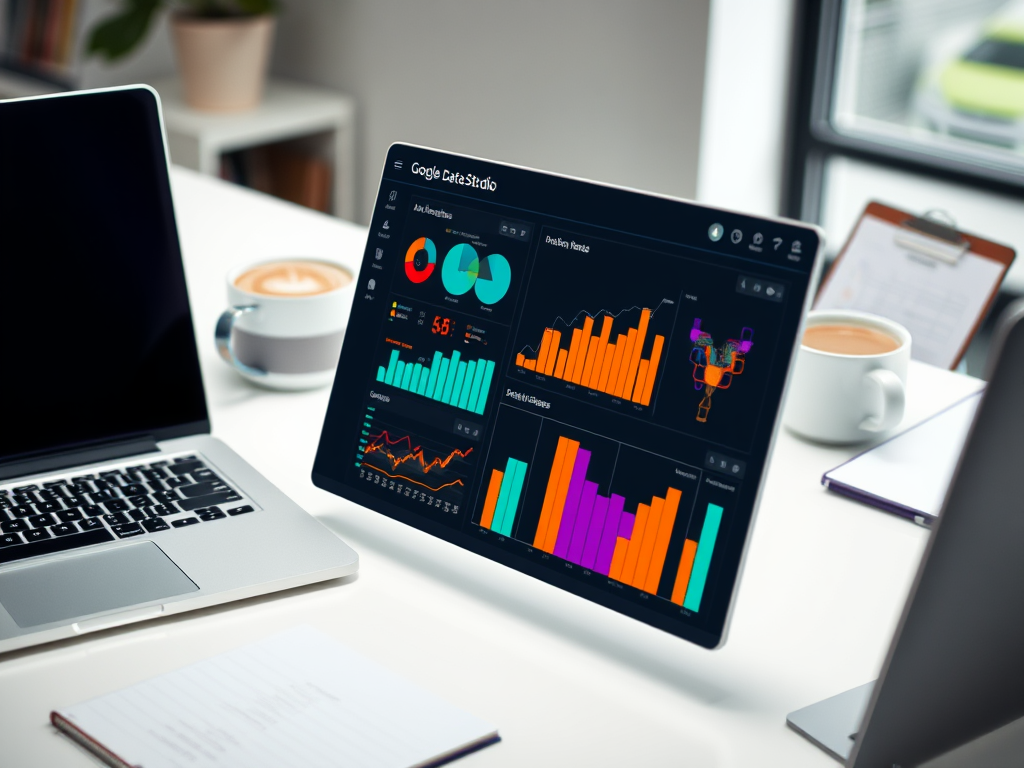In the fast-paced world of digital marketing, having the right tools can make all the difference. One such powerful tool is Google Data Studio, which allows marketers to visualize their data in real time. By transforming raw figures into dynamic dashboards, it empowers businesses to make data-driven decisions that can significantly enhance their marketing effectiveness. With features that support collaboration, customization, and integration with various data sources, Google Data Studio is not just a reporting tool; it’s a game changer. Understanding how to wield this tool effectively can lead to actionable insights that drive success across multiple channels. This article will delve into the benefits, setup, design tips, and advanced features of Google Data Studio, ensuring you can create interactive marketing dashboards that reflect your strategic goals.
Benefits of Using Google Data Studio for Marketing

Google Data Studio comes with a plethora of features that significantly benefit marketers. First and foremost, it enhances data visualization, making it easier to comprehend complex data sets. Marketers can translate numbers into visuals that tell a story, revealing trends, patterns, and outliers that might otherwise go unnoticed. Additionally, real-time data updates are an essential element of the tool; they allow marketers to react promptly to changes in consumer behavior or market conditions. This responsiveness can elevate a marketing strategy from reactive to proactive, creating opportunities for engagement that are timely and relevant.
Enhanced Visualization
The ability to create stunning visual representations of data is arguably one of the standout features of Google Data Studio. Unlike traditional spreadsheets, which can be dense and overwhelming, Data Studio’s diagrams and charts engage users quickly and effectively. This enhanced visualization empowers team members—regardless of their technical background—to derive meaningful insights without the heavy lifting often associated with traditional data analysis.
Real-Time Data Updates
The capacity for real-time data updates enables businesses to maintain agility in their marketing strategies. This means that whether spikes in website traffic from a successful ad campaign or drops in engagement metrics, you can see everything as it unfolds. Therefore, marketers can adjust their tactics on the fly, ensuring they are consistently aligned with current trends. This feature is not just a luxury but a necessity in today’s digital landscape where data quickly becomes outdated. It brings a new level of accountability and evidence-based strategy to marketing decisions.
Getting Started with Google Data Studio

For those new to Google Data Studio, getting started may seem daunting. However, setting up an account and creating your first dashboard is quite user-friendly. After signing in with a Google account, you can begin exploring the platform without much hassle. Before long, you’ll find yourself able to connect various data sources, thus expanding the breadth of insights you can visualize. Below is a simple guideline that outlines the essential steps.
Creating Your First Dashboard
To construct your first dashboard, follow these steps:
- Click on the “Blank Report” button once you log in.
- Select the data sources you want to connect to ensure your dashboard is filled with relevant data.
- Drag and drop different visualization widgets to your workspace.
- Customize each widget by selecting dimensions and metrics that matter to you.
- Add filters to refine the data shown.
- Finally, share your dashboard with your team for feedback and collaboration.
Connecting to Data Sources
Integrating your marketing dashboards with data from various sources is crucial for comprehensive analysis. Google Data Studio supports many platforms, allowing you to unify all your metrics into one dashboard. Popular sources you might consider include:
- Google Analytics
- Google Ads
- Social Media Platforms (Facebook, Twitter, LinkedIn)
- Google Sheets
- SQL Databases
Connecting these sources is generally straightforward, as the platform provides connectors to enable the integration process. By amalgamating data, you can pave the way for more enriched and meaningful reporting.
| Data Source | Type | Frequency of Updates |
|---|---|---|
| Google Analytics | Web Analytics | Real-Time |
| Google Ads | Advertising | Real-Time |
| CRM Systems | Sales Data | Daily |
Designing Effective Marketing Dashboards
Once your data sources are connected, it’s time to focus on designing your dashboard. The design is crucial as it impacts data interpretation and usability. An effective dashboard must be both visually appealing and functional. Selecting the right widgets and customizing them for your target audience can mean the difference between actionable insights and confusion. The goal is to make complex data simple and accessible, thereby empowering users to make decisions easily and effectively.
Choosing the Right Widgets
Google Data Studio offers a variety of widgets designed to display different types of data. The following types might suit your needs:
- Scorecards: Ideal for showcasing KPIs.
- Time Series Charts: Excellent for visualizing changes over time.
- Bar and Pie Charts: Useful for comparisons among categories.
Selecting the appropriate widget based on the data you need to portray is essential for effective communication of insights. A well-crafted dashboard can transform the way stakeholders view data.
Customizing Your Dashboard
Customization is where your dashboard can truly shine. Tailoring your dashboard elements allows for better engagement from your audience. You can adjust color schemes to align with your brand’s identity, configure layouts that suit different viewing devices, and even implement interactive features like filtering options to enhance user experience. Custom queries can also help focus on specific segments deeper.
Integrating Google Data Studio with Other Tools
For a more comprehensive analysis, integrating Google Data Studio with additional tools can amplify its functionality. API connections allow for automated data retrieval from various applications, streamlining the reporting process. Furthermore, incorporating third-party integrations can provide richer insights, offering expansive data sets from which to draw conclusions. Examples of some popular tools to consider include:
- Supermetrics
- Google Sheets
- Facebook Ads
By exploring various integrations, you can create a robust analytical environment that serves multiple marketing needs, thereby enhancing your storytelling capabilities with data.
Analyzing and Interpreting Your Dashboard Data
The real purpose of creating these dashboards is to analyze and act on the data presented. Identifying key metrics is a critical first step in this analytical journey. Doing so ensures that the focus remains on what truly matters to your marketing objectives. Various strategies can be employed to leverage insights gained from dashboards effectively. Regular reviews, A/B testing based on metrics, and iterative improvements can all lead to enhanced performance.
Identifying Key Metrics
Selecting the right key performance indicators (KPIs) can significantly impact your marketing effectiveness. Common KPIs marketers should consider include:
- Customer Acquisition Cost (CAC)
- Return on Investment (ROI)
- Click-Through Rate (CTR)
- Customer Lifetime Value (CLV)
This metric selection plays a pivotal role in how the dashboard informs your strategy. Once you identify which metrics are crucial, you can align your data analysis efforts accordingly.
Making Data-Driven Decisions
To effectively leverage insights, data-driven decision-making must be at the forefront of your marketing strategy. The combination of accurate data interpretation and timely action can lead to substantial improvements in marketing efforts. By using the dashboards to visualize trends, you can pivot your strategies or amplify winning tactics.
Итог
In conclusion, Google Data Studio is an invaluable asset for creating interactive marketing dashboards. Its array of features, from real-time data updates to customizable visualizations, empowers marketers to harness their data effectively. The collaborative and integrative capabilities allow teams to derive insights collectively, enabling businesses to stay ahead in a competitive landscape. Whether you’re analyzing website traffic or figuring out the effectiveness of ad campaigns, Google Data Studio can transform your data into strategic assets. As you become more adept at using this tool, you’ll uncover new opportunities and optimize your marketing efforts with confidence.
Часто задаваемые вопросы
- What is Google Data Studio? Google Data Studio is a free reporting tool that converts your data into customizable, informative dashboards and reports.
- Is Google Data Studio user-friendly for beginners? Yes, Google Data Studio is designed to be intuitive, allowing even those with minimal technical skills to create dashboards.
- Can I share my Google Data Studio reports with others? Absolutely! Google Data Studio enables you to share reports with team members and stakeholders easily.
- What types of data sources can be connected to Google Data Studio? You can connect Google Analytics, Google Ads, Sheets, SQL databases, and many third-party services via connectors.
- Is Google Data Studio free to use? Yes, Google Data Studio is completely free to use for anyone with a Google account.
